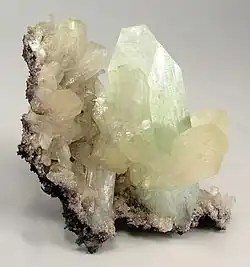Fluorapophyllite-(K)
| Fluorapophyllite-(K) | |
|---|---|
-Gyrolite-145017.jpg) | |
| General | |
| Category | Phyllosilicate |
| Formula | KCa4Si8O20(F,OH)·8(H2O) |
| IMA symbol | Fapo-K[1] |
| Strunz classification | 9.EA.15 |
| Crystal system | Tetragonal |
| Crystal class | Ditetragonal dipyramidal (4/mmm) H–M symbol: (4/m 2/m 2/m) |
| Space group | P4/mnc |
| Unit cell | a = 8.963(2), c = 15.804(2) [Å]; Z = 2 |
| Identification | |
| Color | Colorless, white, pink, pale, yellow, green; in thin section, colorless |
| Crystal habit | Tabular to prismatic crystals; may be pseudocubic |
| Twinning | Rare on {111} |
| Cleavage | Perfect on {001}, imperfect on {110} |
| Fracture | Uneven |
| Tenacity | Brittle |
| Mohs scale hardness | 4.5–5 |
| Luster | Vitreous, pearly on {001} |
| Diaphaneity | Transparent to translucent |
| Specific gravity | 2.33–2.37 |
| Optical properties | Uniaxial (+) |
| Refractive index | nω = 1.530 – 1.536 nε = 1.532 – 1.538 |
| Birefringence | δ = 0.002 |
| Dispersion | High, may be anomalous |
| References | [2][3] |
Fluorapophyllite-(K), formerly known as apophyllite-(KF)[3] and sometimes simply referred to as fluorapophyllite, is the most common mineral of the apophyllite group,[4] with the chemical formula of KCa4Si8O20(F,OH)·8(H2O). It gets the first part of its name, "fluor", because it contains more fluorine than hydroxide compared to the other minerals in the apophyllite group.
Fluorapophyllite crystallizes in the tetragonal crystal system.[5] Tetragonal minerals have three axes of different lengths and angles of 90 degrees. Fluorapophyllite is an anisotropic mineral and has low relief. This mineral belongs to the uniaxial (+) optical class, which means its indicatrix has a prolate sphenoid shape with a circular section, principal section, and one optic axis.[6]
Fluorapophyllite is popular among many mineral collectors because of the large, well-developed crystals they form and the multiple colors they come in. The most wanted variation of fluorapophyllite is the green colored variant, which is found in India. Fluorapophyllite is also found in New Jersey of the United States.[7] This mineral is found as a secondary mineral in vesicles in volcanic rocks such as basalt.
Images
-
 Stilbite crystals surround a pastel green, translucent fluorapophyllite crystal
Stilbite crystals surround a pastel green, translucent fluorapophyllite crystal -
-66684.jpg) Isolated apophyllite cluster on contrasting matrix
Isolated apophyllite cluster on contrasting matrix -
-131740.jpg) A radial cluster of cubically-tipped apophyllite crystals
A radial cluster of cubically-tipped apophyllite crystals -
-Stilbite-Ca-Calcite-171681.jpg) Light green form from Pune District, Maharashtra, India
Light green form from Pune District, Maharashtra, India
References
- ^ Warr, L.N. (2021). "IMA–CNMNC approved mineral symbols". Mineralogical Magazine. 85 (3): 291–320. Bibcode:2021MinM...85..291W. doi:10.1180/mgm.2021.43. S2CID 235729616.
- ^ Handbook of Mineralogy
- ^ a b "Fluorapophyllite-(K)". mindat.org. Hudson Institute of Mineralogy. Retrieved 18 July 2025.
- ^ "Apophyllite Group". mindat.org. Hudson Institute of Mineralogy. Retrieved 18 July 2025.
- ^ Johnsen, O. (2002) Photographic Guide to Minerals of the World. 439 p. Oxford University Press, Great Clarendon Street, Oxford.
- ^ "Archived copy" (PDF). Archived from the original (PDF) on 2010-10-10. Retrieved 2010-12-03.
{{cite web}}: CS1 maint: archived copy as title (link) - ^ Cook, Robert B. (1995) Fluorapophyllite. Rocks and Minerals, 70. 394–398.